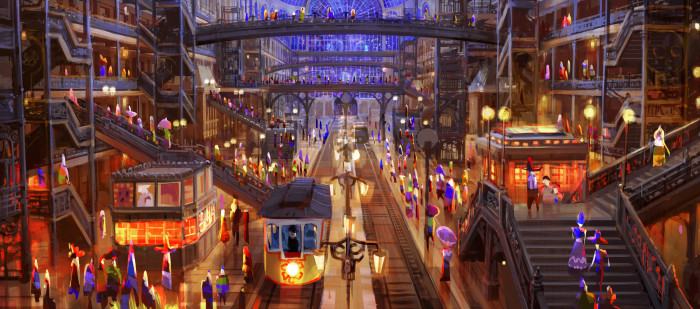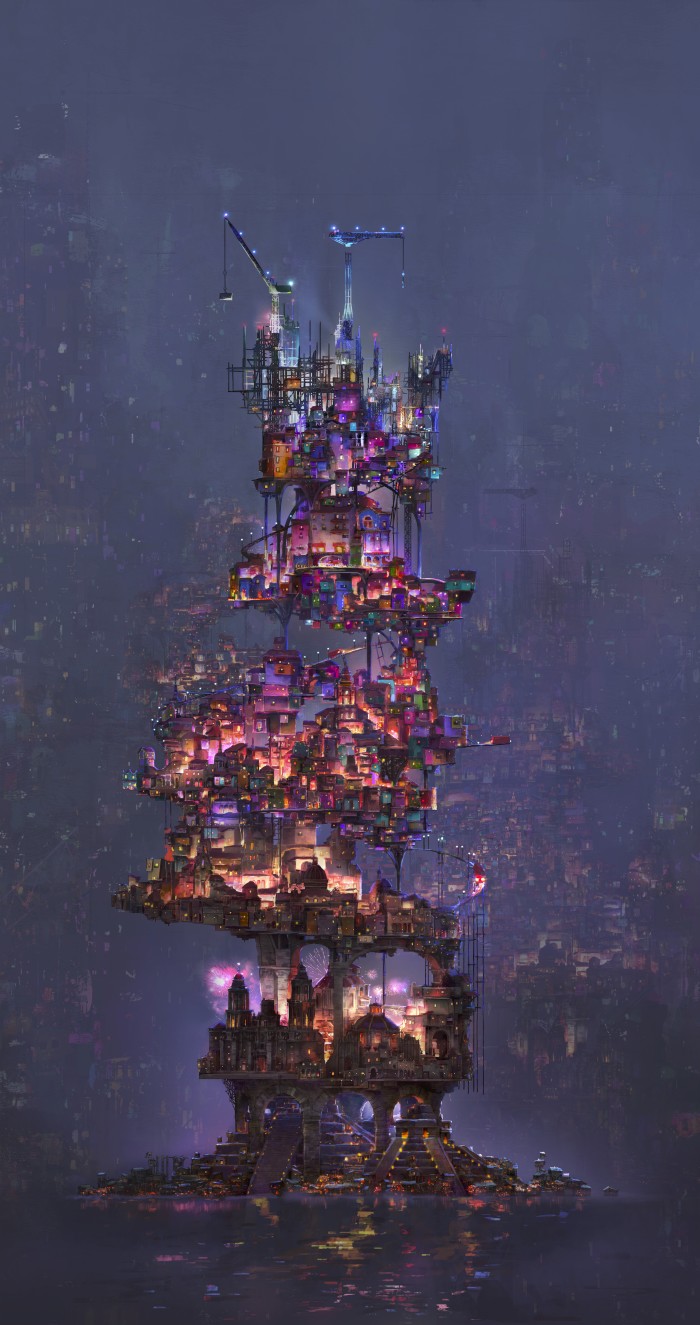How 'Coco' Was Influenced By 'John Wick', 'Spirited Away,' And Mexican History
In Pixar's Coco, the Land of the Dead is a stunning piece of animation, embedded with tiny pinpricks of light scattered throughout precarious towers of houses stacked upon houses. And springing out of this land are luminescent bridges made of marigold, bridging the way from the Land of the Dead to the Land of the Living.
It's a majestic sight that's all at once familiar and unfamiliar, as the production and set designers of Coco wanted to forge their own paths independent of animated films that evoked the afterlife before them — like The Book of Life or The Corpse Bride — but at the same time pay homage to the rich Mexican landscape in which the film is set.
"Mexico is a designer's dream and I knew that we would feature the rich colors and textures that we saw there," production designer Harvey Jessup said.
Like Night and Day
The designers of the Land of the Dead and Santa Cecilia, Miguel's home in the land of the living, referenced many of the historic and modern cities of Mexico they researched during their multiple trips to Mexico in the years building up to Coco. There had to be a clear difference between the two other than the cities they were influenced by — Santa Fe de la Laguna for Santa Cecilia, Guanajuato and its multilayered city with underground tunnels for the Land of the Dead — Jessup said:
Danielle [Feinberg, the director of photography lighting] and I worked with Lee [Unkrich] to outline the differences between the land of the living and the land of the dead. Two-thirds of the film is set at night and that was a major consideration. We knew that the daytime scenes, the whitewashed walls of Santa Cecilia would contrast with the cool colors and rough streets of the Land of the Dead.
The Land of the Dead is a setting that is perpetually at night, which offered some challenges for Feinberg, who specialized in using color as a sort of mood board for the movie — dark colors evoked darker emotions, while lighter colors evoked positive ones. It's visual storytelling 101, but Feinberg had to throw much of that out for Coco:
What we're doing is mapping out the emotion of the scene...so we're thinking about things like time of day, what the weather is, what colors we're using to dictate the emotion. We realized we're going to have a significant challenge, because for time of day, it's always night, for weather there is no weather, and for color it's every color you can imagine.
Feinberg used their experience in Mexico to as a guideline for how to light the Land of the Dead without impacting the film's color script. She "got inspiration from candles at the cemeteries and all the different kinds of lights like the fluorescent lights coming from a single bulb hanging on a wire at a street vendor, cemeteries where you get a 'blanket of candlelight,' but another color light is hanging from a tree..." The vibrant colors of the Day of the Dead helped her case as well, allowing her to bathe the Land of the Dead in the festive party lights that Mexico is decorated with every year. In fact, the multitude of lights in the Land of the Dead were so vibrant that they threatened to (literally) outshine the living city of Santa Cecilia, which is depicted as a dusty town that houses Miguel's straight-laced family. But each land had their own distinct colors and looks, Feinberg said:
When we get into Santa Cecilia, we're leaving room for the vibrancy of the Land of the Dead, but still keeping it this cheerful place. We never want it to feel bleak because we're honoring the Mexico that we thought was so rich and wonderful, by having these sunny, wonderful colors bleached out by the sun, and layers of aging. Which also leaves room for the decorations of the holiday to really pop out.
History in the Making
The City of the Dead has an almost steampunk quality to it, with spires and industralist metalwork and structures hanging off humble, older houses. But the Coco design team didn't always set out to make it this way. Chris Bernadi, the sets supervisor, revealed some of their early ideas for the Land of the Dead, including a literal Tree of Life, a vast futuristic modern city, and more. Without a universal idea of what Mexicans thought the afterlife looked like, Bernadi and his team were given the task of thinking it up from scratch. He said:
City of the Dead was really a unique challenge for us where Lee asked us to create a world that was like something no one had ever seen before.
But of course, everything in history has been seen by someone, at some point. So Bernadi and the design team did just that — draw from Mexican history to build their surreal city.
We went back to reference the city of Oaxaca which inspired a lot of the Land of the Dead, and we noticed that there were these buildings that looked like they were jammed into other buildings, where there was plaster and stone, and it looked like some buildings were just hanging off structures. And they formed at some of these interesting angles to form neighborhoods. Some of that verticality that we were hoping to capture.
Oaxaca — as well as Mexico City, which Bernadi liked for its watery surroundings — formed the basis for their city. They jammed houses and structures into each other to create these unwieldy, spiraling towers that are forever ascending as long as there are people to pass through the afterlife. And in doing so, they created their own history, Bernadi said:
In the towers, history is sort of spelled our for us in that height of the towers. The idea is that when this was first populated, it was ancient cultures and primitive cultures, leading to sort of Mayan pyramids and stone structures, that led to colonial era civic buildings, that led to mid-20th century, up to modern construction. People are always dying so the land is always growing, it's this dynamic sort of place.
Trolley tracks and streets twisting around the city formed the cohesive element tying their awe-inspiring towers together. And more elements of history had been mashed into the Land of the Dead as well, with Marigold Station serving as a "sort of Victorian DMV," where skeletons have to pass through red tape even in the afterlife in order to see their loved ones. And this being Pixar, some easter eggs of skull images are strewn across the Land of the Dead, "some fixed, some ephemeral," to subtly remind you that this was a different place. And Lee Unkrich guarantees that there are at least three The Shining references in the movie.
Lights, Camera, Movie Influences
The Land of the Dead is lit by 7 million pin lights from candles, gondolas, windows, and more, to provide texture and bring out the detail in the buildings and structures. The glowing fluorescence and neon reminded me of Spirited Away and the steampunk structures even gave shades of Howl's Moving Castle. The surreal, otherworldly quality reminiscent of Studio Ghibli films is something that the Coco team must have intentionally put forward, right? Jessup responded:
We looked at Spirited Away and Howl's Moving Castle at the very beginning. I don't think we lifted anything specific from that, but the spiritual feelings in those Miyazaki films was something we loved, and we tried to get an element of that in our film.
A number of intense lights and colors that Coco's Land of the Dead boasts doesn't — and indeed can't — come solely from the team's experience in Mexico. Feinberg elaborated that the movie was influenced by multiple movies that flagrantly use "crazy colors" and lights, including the action movie John Wick. Feinberg said:
Lee sent me some movies that had some crazy colors in it and I used some of my own. It was a collaboration of sending pictures and incorporating into film. And then we just cranked it to 11.
This isn't a stylized assassin movie, however. Feinberg said they broke up the barrage of intense, bright colors with quiet moments infused with more blue and purple, as well as spotlights of blue from the moon and green light or paint because of the lack of vegetation.
The result is a breathtaking portrait of the afterlife that you won't soon forget.
Coco hits theaters November 22, 2017.


